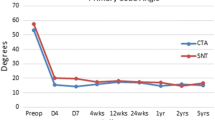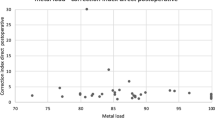Abstract
Purpose
Aim of the study was to evaluate the role of the mechanical properties of the rod and of the characteristics of the patients (age, skeletal maturity, BMI, and Lenke type) in determining the deformity correction, its maintenance over time and the risk of mechanical failure of the instrumentation.
Methods
From March 2011 to December 2014 120 patients affected by AIS underwent posterior instrumented fusion. Two 5.5-mm CoCr rods were implanted in all patients. For every patient, age, sex, Risser grade, Lenke type curve, flexibility of the main curve, body mass index (BMI), and percentage of correction were recorded. In all patients, the Cobb angle value and rod curvature angle (RC) were evaluated. RC changes were registered and correlated to each factor to establish a possible statistically significance in a multivariate analysis. A biomechanical model was constructed to study the influence of rod diameter and material as well as the density of the anchoring implants in determining stress and deformation of rods after contouring and implantation.
Results
Radiographic and biomechanical analysis showed a different mean rod deformation for concave and convex side: 7.8° and 3.9°, respectively. RC mean value at immediate follow-up was 21.8° for the concave side and 14.6° for the convex. At 2-year minimum follow-up, RC value increases 1.5° only for the concave side. At 3.5-year mean follow-up, RC value increases 2.7°, p = 0.003, for the concave side and 1.3° for the convex, p = 0.06. The use of the stiffest material as well as of the lowest diameter resulted in higher stresses in the rods. The use of either a low or a high instrumentation density resulted only in minor differences in the loss of correction.
Conclusions
Rod diameter and material as well as patient characteristics such as BMI, age, and Risser grade play an important role in deformity correction and its maintenance over time.








Similar content being viewed by others
References
Serhan H, Mhatre D, Newton P, Giorgio P, Sturm P (2013) Would CoCr rods provide better correction forces than stainless steel or titanium for rigid scoliosis curves? J Spinal Disord Tech 26(2):E70–E74
Lee SM, Suk SI, Chung ER (2004) Direct vertebral rotation: a new technique of three-dimensional deformity correction with segmental pedicle screw fixation in adolescent idiopathic scoliosis. Spine (Phila Pa 1976) 29:343–349
de Jonge T, Dubousset JF, Illes T (2002) Sagittal plane correction in idiopathic scoliosis. Spine 27:754–760
Wang X, Aubin C, Crandall D, Labelle H (2011) Biomechanical comparison of force levels in spinal instrumentation using monoaxial versus multi degree of freedom postloading pedicle screws. Spine 36:95–104
Salmingo RA, Tadano S, Fujisaki K, Abe Y, Ito M (2013) Relationship of forces acting on implant rods and degree of scoliosis correction. Clin Biomech 28:122–128
De La Rocha A, McClung A, Sucato DJ (2014) Increased body mass index negatively affects patient satisfaction after a posterior fusion and instrumentation for adolescent idiopathic scoliosis. Spine Deform 2(3):208–213
Lenke LG, Betz RR, Harms J, Bridwell KH, Clements DH, Lowe TG, Blanke K (2001) Adolescent idiopathic scoliosis: a new classification to determine extent of spinal arthrodesis. J Bone Joint Surg Am 83(8):1169–1181
Galbusera F, Bassani T, La Barbera L, Ottardi C, Schlager B, Brayda-Bruno M, Villa T, Wilke HJ (2015) Planning the surgical correction of spinal deformities: toward the identification of the biomechanical principles by means of numerical simulation. Front Bioeng Biotechnol 3:178
Galbusera F, Bellini CM, Anasetti F, Ciavarro C, Lovi A, Brayda-Bruno M (2011) Rigid and flexible spinal stabilization devices: a biomechanical comparison. Med Eng Phys 33:490–496
Bridgeport DA, Brantley WA, Herman PF (1993) Cobalt-chromium and nickel-chromium alloys for removable prosthodontics, Part 1: mechanical properties. J Prosthodont 2(3):144–150
Niinomi M (1998) Mechanical properties of biomedical titanium alloys. Mater Sci Eng, A 243:231–236
Paxinos O, Tsitspolos PP, Zindrick MR et al (2010) Evaluation of pullout strength and failure mechanism of posterior instrumentation in normal and osteopenic thoracic vertebrae. J Neurosurg Spine 13:469–476
Metha H, Santos E, Ledonio C et al (2012) Biomechanical analysis of pedicle screw thread differential design in an osteoporotic cadaver mode. Clin Biomech 27:234–240
Salmingo RA, Tadano ST, Abe Y, Ito M (2014) Influence of implant rod curvature on sagittal correction of scoliosis deformity. Spine J 14:1432–1439
Le Navéaux F, Aubin CE, Parent S, Newton OP, Labelle H (2017) 3D rod shape changes in adolescent idiopathic scoliosis instrumentation: how much does it impact correction? Eur Spine J. doi:10.1007/s00586-017-4958-1 [in press]
Han S, Hyun SJ, Kim KJ, Jahng TA, Kim HJ (2017) Comparative study between cobalt chrome and titanium alloy rods for multi-level spinal fusion: proximal junctional kyphosis more frequently occurred in patients having cobalt chrome rods. World Neurosurg S1878–8750(17):30526
Gehrchen M, Ohrt-Nissen S, Hallager DW, Dahl B (2016) A uniquely shaped rod improves curve correction in surgical treatment of adolescent idiopathic scoliosis. Spine (Phila Pa 1976) 41(14):1139–1145
Illés T, Tunyogi-Csapo M, Somoskeoy S (2011) Breakthrough in three-dimensional scoliosis diagnosis: significance of horizontal plane view and vertebra vectors. Eur Spine J 20:135–143
Cowin SC, Sadegh AM, Luo GM (1991) Correction formulae for the misalignement of axes in the measurement of orthotropic elastic constants. J Biomech 24:637–641
Lu TW, O'Connor JJ (1996) Lines of action and moments arms of the major forces bearing structures crossing the human knee joint: comparison between theory and experiment. J Anat 76:4190–4193
Pitzen T, Geisler FH, Matthis D, Muller-Storz H, Pedersen K, Steudel WI (2001) The influence of cancellous bone density on load sharing in human lumbar spine: a comparison between an intact and a surgically altered motion segment. Eur Spine J 10:23–29
Author information
Authors and Affiliations
Corresponding author
Ethics declarations
Conflict of interest
All the authors declare they have no conflict of interest.
Rights and permissions
About this article
Cite this article
Giudici, F., Galbusera, F., Zagra, A. et al. Determinants of the biomechanical and radiological outcome of surgical correction of adolescent idiopathic scoliosis surgery: the role of rod properties and patient characteristics. Eur Spine J 26 (Suppl 4), 524–532 (2017). https://doi.org/10.1007/s00586-017-5148-x
Received:
Revised:
Accepted:
Published:
Issue Date:
DOI: https://doi.org/10.1007/s00586-017-5148-x




